This post may contain affiliate links. Please read our disclosure policy.
An authentic and delicious Italian Tomato Sauce that has been passed down through generations.
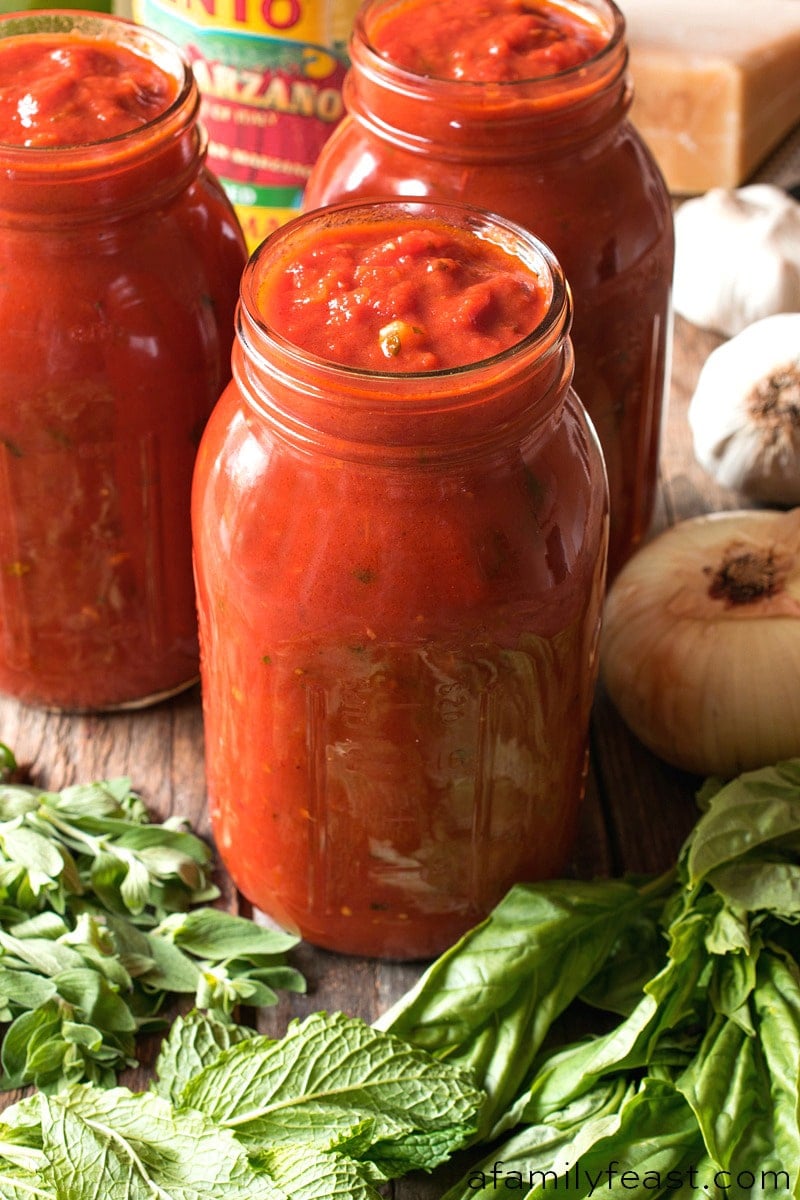
This recipe for Italian Tomato Sauce is a recipe that my husband Jack spent years perfecting. For Jack, knowing how to make a great Italian Tomato Sauce is a very personal thing – and it brings back fond memories of his childhood.
To this day, Jack clearly remembers the amazing smells coming from a pot of tomato sauce that was always simmering away on the stove anytime he visited his Italian grandparents. He worked hard to recreate that wonderful recipe in our own kitchen – and this is it!
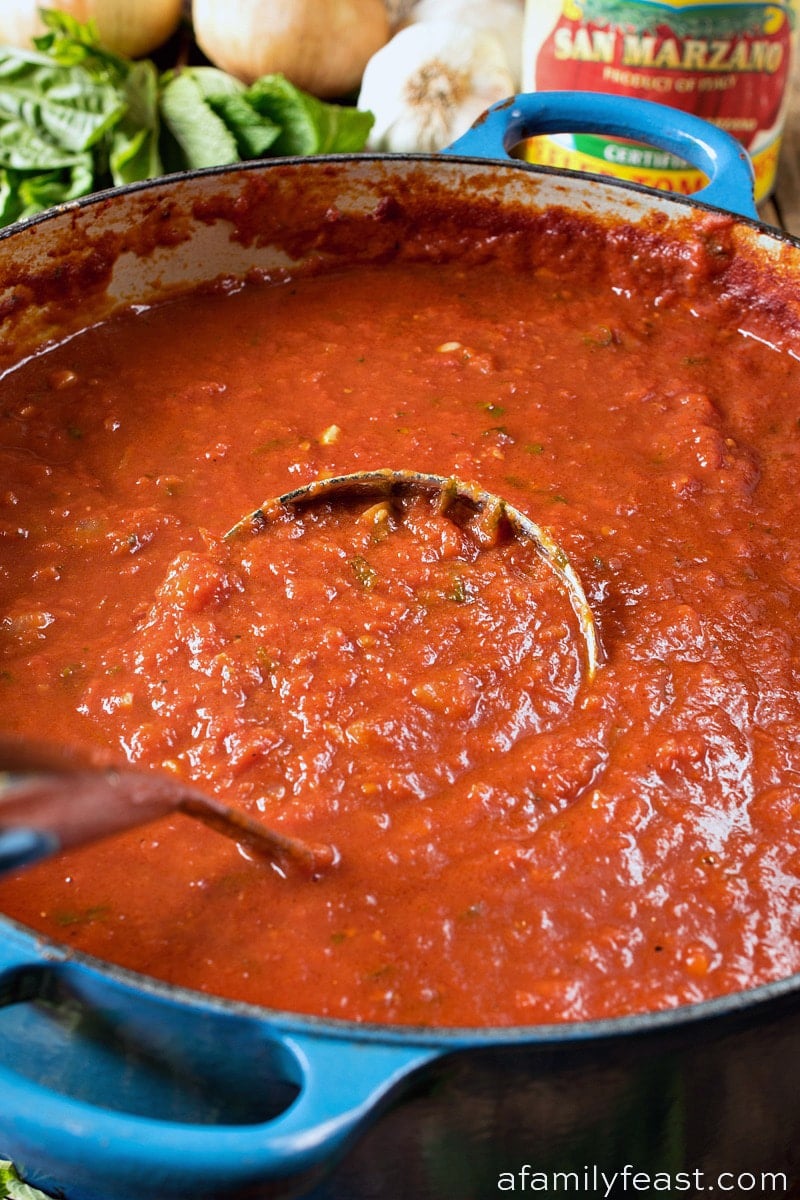
In fact, ever since posting this Italian Tomato Sauce recipe here on A Family Feast back in 2013, we’ve had so many readers write to us to tell us how much they love this sauce. And, many of our readers have told us that they now consider this their ‘go-to’ Italian tomato sauce recipe. (Note: We haven’t made any changes to the recipe over the years, we just included some updated photos today!)
There are so many different ways to make an Italian Tomato Sauce and depending on whom you ask – and where their family originally came from – you will find many different family recipes. Some use different types of tomatoes, some with or without meat, some cooked for a long time giving the sauce a deep, rich taste and others cooked for just a short time for a light fresh taste. Some families even refer to their Italian tomato sauce as Sunday Gravy or Marinara. (Click on those links – we have our own version of those recipes too!)
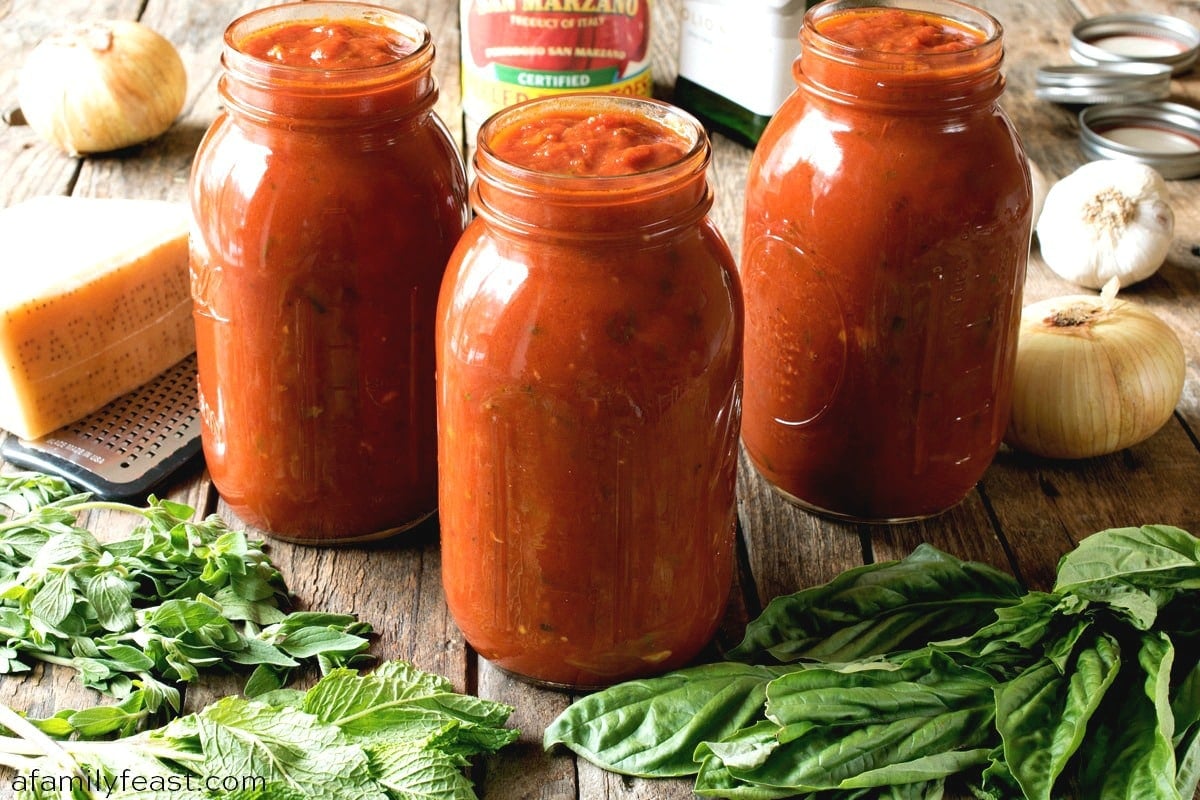
What’s the difference between Italian Tomato Sauce, Sunday Gravy, Marinara Sauce and other kinds of sauces?
- For Jack, an Italian Tomato Sauce is a tomato-based sauce that simmers for a long time on the stove so that the flavors really deepen and develop. (This recipe is a delicious example!)
- A Sunday Gravy recipe is a tomato sauce cooked along with a variety of meats including meatballs, spare ribs, sausage, and pork chops, so the sauce picks up additional flavor from the meat.
- Finally, Marinara is also a tomato-based sauce, but it’s a quickly-cooked sauce, yielding a bright, fresh tomato flavor.
- And – since we’re talking about all types of tomato sauces – we also have a Roasted Tomato Pizza Sauce recipe AND an Easy No-Cook Pizza Sauce recipe you might be interested in checking out too. Pizza sauces typically have a bold flavor that is meant to both complement and shine through the flavors of the dough, cheese and toppings on a pizza.
- We also have recipes for Bolognese (a meat sauce that is cooked low and slow with milk), a more traditional Italian Meat Sauce (made with ground beef and Italian sausage), and finally an Italian Meat Ragu (made with shredded beef and other ingredients).

Today’s recipe is originally inspired by a version of Italian Tomato Sauce that Jack grew up with, and he credits his Aunt Mary for this recipe, plus some additional influences from the sauce that Jack’s father (aka Grampa) used to make. If you happen to be growing San Marzano Pomodoro tomatoes in your garden – definitely use those! However, if fresh tomatoes aren’t available, we think some of the best San Marzano Pomodoro canned tomatoes are made by Cento and Pastene – and both brands are readily available at most local grocery stores.
Mangia!
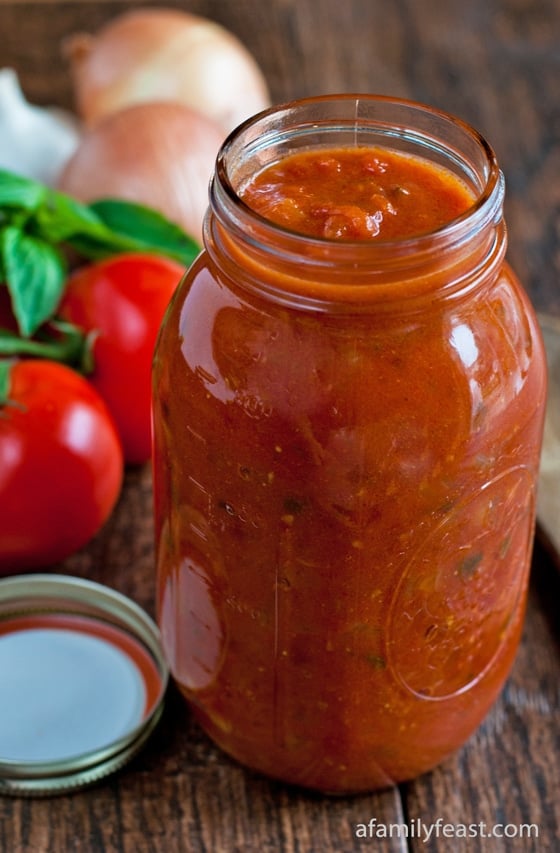
P.S. We freeze our Italian Tomato Sauce in gallon zipper seal bags for long-term storage, laying the bags flat after filling and squeezing out any excess air. Freeze the bags flat on a sheet pan, then once frozen you can fit them more easily in your freezer. For information on how to can a high-acid food like tomato sauce, we suggest that you visit the Ball Canning website here. Here is another interesting link about canning tomato sauce which suggests that the pressure method should be used to ensure safe canning of any homemade tomato sauce.
You may also like these other Italian family classics:
- Marinara Sauce
- Nanny’s Italian Stuffed Peppers
- Classic Lasagna
- Sunday Gravy
- Grandma Gennaco’s Beef Braciole
We love seeing what you made! Tag us on Instagram at @afamilyfeast or hashtag #afamilyfeast so we can see your creations!

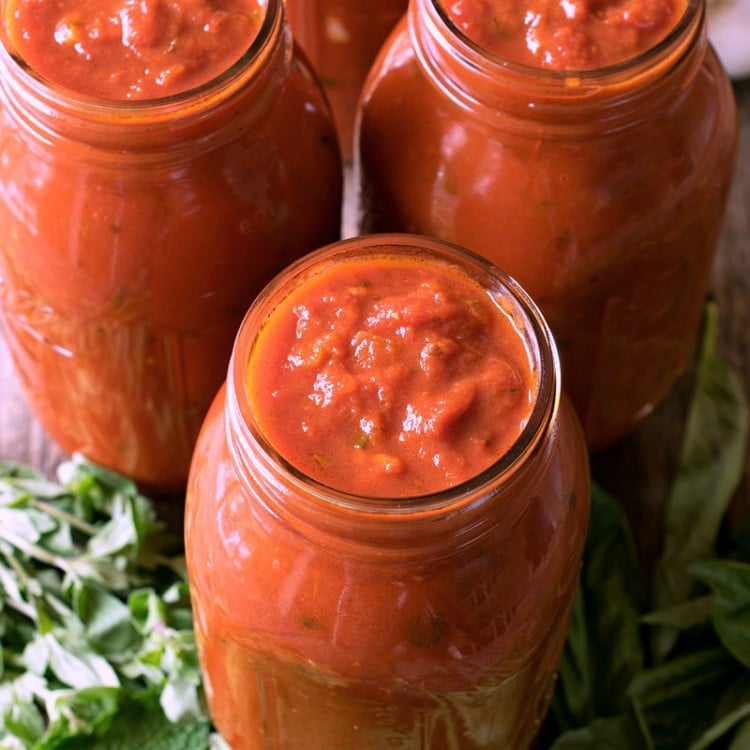
Italian Tomato Sauce
An authentic and delicious Italian Tomato Sauce that has been passed down through generations.
Ingredients
- 1/3 cup good quality extra virgin olive oil
- Pinch of red pepper flakes
- 4 crushed garlic cloves
- 3/4 cup chopped onion (optional)
- 1 teaspoon fresh chopped oregano, divided, or 1/2 teaspoon dried
- 1 tablespoon chopped fresh basil, divided, or 1/2 tablespoon dried
- 1 teaspoon fresh chopped mint, divided
- 1 teaspoon sugar
- 1 teaspoon salt
- 1/4 teaspoon freshly ground black pepper
- 2 28–ounce cans of whole tomatoes or two quarts of freshly canned garden tomatoes
- 1/4 cup freshly grated Parmesano Reggiano cheese
- 2 tablespoons unsalted butter
Instructions
- Before you begin, pour your two cans of tomatoes into a bowl and crush with your hand. Don’t break them up too small, you want large chunks.
- In a large heavy bottomed pot with a lid, on a burner with no flame, pour in olive oil and add red pepper flakes, garlic, onion, most of the oregano, basil and mint (save a little bit of each for the end), sugar salt and pepper. Turn on the burner and slowly bring up to hot. (See Notes below.) When the onions and garlic start to cook, stir and heat for five minutes.
- Remove the pot from the burner and place a heat diffuser over the burner. Place the pot over the heat diffuser and add the tomatoes. Turn burner to medium high and stir until they start to boil. Then reduce to simmer, partially cover and simmer 90 minutes.
- After 90 minutes, remove from heat and add the reserved herbs and Parmesan cheese. Add the butter to round out the flavors. Stir again and serve.
Last Step! Please leave a review and rating letting us know how you liked this recipe! This helps our business thrive & continue providing free recipes.
Notes
An important first step to note when making this sauce is to bring the olive oil up to temperature very slowly with the garlic, herbs, and spices, and cook for about five minutes to brown the garlic. This is a step that Jack has seen referenced in a number of great Italian cookbooks and although not clearly stated why, we believe this slow heat-up process allows the oil to be infused with the seasonings providing a really delicious base to your sauce.
The old saying about the sauce tasting better the next day reheated is true. It gives the flavors a chance to blend and mellow out.
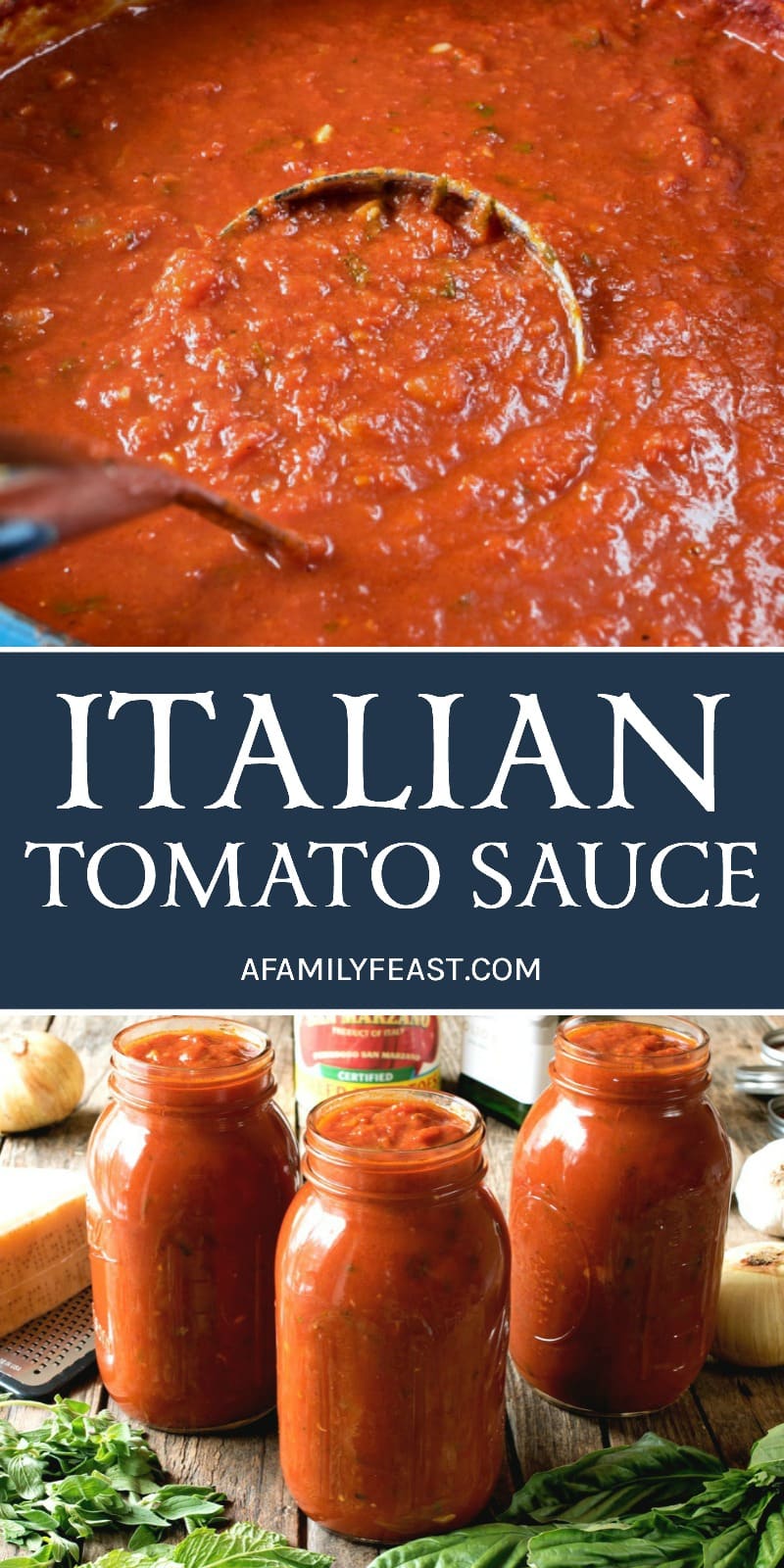

I did leave out the mint but it was delicious! I loved the thickness of the sauce-definitely not runny! This is my go to sauce I do not buy store bottled anymore! Today I’m doubling and putting it in 2 cup and 1 cup freezer bags ! Thank you for a simple yet yummy sauce!
You’re very welcome Sue!
For sure a 5 Star!👍🏻 Its not only delish but The recipe said the yield is
1 1/2 quarts and that is what I got exactly
Thanks Jan!
I am excited to try your recipe. We are going to use freshly picked tomatoes from our garden. Your recipe calls for canned whole tomatoes or canned garden tomatoes. Can we skip canning our garden tomatoes and just cut them up and add to the sauce? If the answer is yes, would we use 2 quarts of cut up fresh tomatoes? Thank you!
Hi Marsha – You would use the equivalent weight of fresh as the canned in the recipe (so about 3-1/2 to 4 pounds of fresh) – and yes – no need to can them first. You will want to remove the skins from the tomatoes before adding them to the sauce. Bring some water to a boil; then cut an X in the bottom of each tomato before putting it into the boiling water. Leave in boiling water until the skin starts to peel (just a minute or so). With a slotted spoon, remove them to an ice water bath to cool quickly. Once cool enough to handle, remove to a sheet tray. Skin will peel right off. Pinch green stem and twist and pull. What is left will all be usable for the sauce – and add all of the juices that seep out as you work on the tomatoes.
Also note that fresh tomatoes have an overall higher water content than canned, so you may need to simmer the sauce for longer to get the thickness you’d like. You may also want to have some tomato paste on hand in case you need to thicken it further – the paste will also add some richness and flavor to the sauce so start with a little and add more as needed.
Ich bin begeistert,das Rezept habe ich bei Pinterest gefunden,und da gerade die Tomaten reif sind,gleich ausprobiert. Ein Geschmackserlebnis,bleibt mein Favorit.
Danke Marina! 🙂
My family does not like chunks of tomatoes in their sauce. I looked at this recipe for your old fashion classic lasagna Now sure how I end up with 12 ozonces ? And what is a heat diffuser? Thank uou
Hi Pat – This sauce recipe makes a total of 1.5 quarts so you’ll have extra sauce for another recipe. (You can freeze it in zipper seal bags.) A heat diffuser is a flat metal tool that you put under the pot so the sauce won’t scorch. (We link to the one we have in the post.) If you don’t have one or want to buy one, just be sure to stir the sauce frequently as it cooks instead.
There was no reference as to the weight if using fresh tomatoes and no reference to how the fresh tomatoes would be prepared ie: skinless, pulp out
Hi Lazarus – You are correct, this recipe is made with canned San Marzanos…most of our US-based readers would have to rely upon canned as San Marzanos are not readily available at most supermarkets. Having said that, if you have fresh tomatoes – San Marzano or plum/Roma – you would use the same amount in weight as called for in the recipe and peel them as follows: Bring some water to a boil; then cut an X in the bottom of each tomato before putting it into the boiling water. Leave in boiling water until the skin starts to peel (just a minute or so). With a slotted spoon, remove them to an ice water bath to cool quickly. Once cool enough to handle, remove to a sheet tray. Skin will peel right off. Pinch green stem and twist and pull. What is left will all be usable for the sauce. If you have a lot of seeds, you can press the pull through a china cap strainer or a food mill. Plum tomatoes usually have few seeds so you might not need to worry about this step. Also note that you may need to simmer the fresh tomato sauce for longer and you might want to add some tomato paste to thicken and make the sauce richer. Sometimes making sauce from fresh tomatoes rather than canned results in a thinner/more watery sauce. I hope that helps!
Chef Martha, I noticed that there haven’t been comments for about 10 years…so I thought I would throw my opinion in. I have used this sauce recipe for YEARS now and want to finally thank you for this recipe. I am an amateur chef with restaurant experience back in the early 1980’s..,then went another direction (military, 101st Airborne, Gulf War, adventures untold). Returned to home in 1995 and have used cooking at night as my relax from a hard day’s work. I cook many different cuisines, and my wife of 34 years always does the dishes. When it is time to make a batch of sauce…this is where I go.thank you so much, Chef. Respect! Jeff in Houston
Thank you so much Jeff! We’re honored!
And when the comments refreshed, I saw that comments flow in over the years. My mistake.
And it is MY honor to use y’all’s recipe!
No worries! We’re so glad you enjoy the recipe. ☺️
My absolute go-to recipe whenever we get fresh tomatoes in Provence 😘😊
Thank you!
I’ve loved this sauce ever since I discovered it a couple of years ago!! I always make it in spring and the summer😊
So glad you enjoy the recipe Kavita!
Very tasty recipe I made it was I bit time consuming,but very much worth it.
Thank you Edna – glad you enjoyed the sauce!